Seeing American Ballet Theatre during its too-brief season at City Center (nine works and eight performances in five days) could give spectators who devour the company’s spring shows at the Metropolitan Opera a new slant on the dancers. No tutus or tiaras on view, no see-me-ace-this displays of virtuosity, no hordes of elaborately costumed courtiers standing around watching some princess do what it takes to live happily ever after.
And we get to see the splendid dancers in a more intimate setting. In fact, since most of the music was on tape for these November performances, people sitting where an orchestra pit might be were only a few yards away from the flying sweat and heavy breathing. The largest cast (for Paul Taylor’s Black Tuesday) numbered 14.
Seven of the offerings—works ABT has performed before—were by choreographers associated with modern dance: Merce Cunningham, Twyla Tharp, Paul Taylor, and Martha Clarke. There was some wonderful dancing on view in this potpourri of styles—frequently by corps de ballet members in leading roles. For example, Luciana Paris and her partner, Alexandre Hammoudi move with silky, rueful elegance in “Slumming on Park Avenue” in Taylor’s Black Tuesday (2001). Paris is valiant and charming, if a little less secure, in Tharp’s 1983 Sinatra Suite with the great Herman Cornejo (occasionally in the opening “Strangers in the Night,” she stops the dreamy flow by giving a little extra push to her arabesque to get her leg as high as she wants it).
Julio Bragado-Young is very fine in both the impromptu soft shoe number with Sean Stewart in Black Tuesday and as the proper, bespectacled gentleman in Clarke’s The Garden of Villandry. Stewart and Adrienne Schulte excel in their blithe, light-footed couple dance in Cunningham’s Duets. Small, slight Gemma Bond solos beguilingly as the spunky, street-wise ragamuffin in Taylor’s take on the Depression-era poor. Arron Scott is one of the standouts in Tharp’s tremendous In the Upper Room (1986). And Nicola Curry deserves to be complimented for more than her dancing. I wonder how she felt on learning that she, a member of the corps de ballet, was to perform a sizeable solo number on Black Tuesday‘s down-and-out vaudeville bill, and then finding out that she had to dance “Sittin’ on a Rubbish Can” with padding under her Santo Loquasto costume. Leave it to Taylor to decide that one of these nimble victims of the Panic of 1929 should be an expectant mother.
In the Upper Room, which entered ABT’s repertory in 1988, was the culminating piece of several in which Tharp juxtaposed ballet to her own jazz-influenced style of modern dance. Beginning in 1971, with a lec-dem in her The Bix Pieces, Tharp several times juxtaposed two styles of dancing in her works—most memorably in the 1973 Deuce Coupe, originally performed by the Joffrey Ballet and members of her own company. In these pieces, Tharp seemed to be saying, “look, folks, ballet and my kind of dance are kin. Why not let them play together and see what happens?”
A lot happens in In the Upper Room, thanks to Tharp’s ingenious choreography, Jennifer Tipton’s lighting and smoke effects, Norma Kamali’s shifting array of red and black-and-white costumes, and Philip Glass’s score, whose repetitive patterns are swirled into the stratosphere by transpositions upward and contrasting orchestrations for the various sections of the work (now brasses sing out, now the piano quiets things down, now voices chant triumphant holiness). The squad of dancers swinging their arms and stomping around in sneakers and the group wearing ballet slippers (with the women on pointe) and engaging in classical maneuvers gradually infiltrate one another’s ranks. Gennadi Saveliev of the ballet contingent leaves off partnering Paloma Herrera to have a go with leading stomper Gillian Murphy. Ballet-man Scott goes to town with stomper Kristi Boone. The male stompers (Sasha Radetsky, Blaine Hoven, and Patrick Ogle retain their power), and so do their women (Murphy, Boone, and Misty Copeland, plus Luciana Voltolini, who also doubles in the ballet contingent), but they have a certain elegance. And members of the ballet group (Herrera, Saveliev, Scott, Craig Salstein, Maria Riccetto, and Isabella Boyleston), become increasingly fluid. Coached by former Tharp dancer Stacy Caddell, who did the re-staging, the ABT performers have, for the most part, captured Tharp’s style admirably.
This is one of those Tharp works that affirm dancers as heroes—daring, unafraid, dauntless. As they leap and spin into their enmeshed intricacies, and Riccetto and Boyleston stitch yet another of their lightning-footed phrases across the stage, I begin to think that In the Upper Room will never end. I don’t want it to end. It ends.
It’s a great pleasure to see leading dancers change and grow. In the past, Herrera has often seemed to me almost too grand in her tutu roles, but she’s a champ in Upper Room and one of the finest performers in Cunningham’s Duets. In this 1980 work (taken into ABT’s repertory two years later), Herrera is almost unrecognizable at first without her ballerina makeup. Excellently partnered by corps member Eric Tamm, she aces the difficult pas de deux in which the woman must repeatedly race to the man and vault onto his shoulder, but she also brings out the quiet sensuality of those moments when she leans back against Tamm and gazes into the distance.
Cunningham’s choreography must be difficult for ballet dancers. Unlike most music for dance, John Cage’s clangorously percussive Variations III, doesn’t support their actions or dictate their rhythms. Although this particular dance involves the high leg extensions and fast footwork that they excel at, Cunningham’s choreography tilts and angles their bodies in unfamiliar ways and connects partners in positions that border—beautifully—on awkwardness.
The performing manner in a Cunningham piece is meant to be natural—the dancers both at ease and as alert as animals in the wild, each movement seeming a discovery or a rediscovery. Ex-Cunningham dancer Patricia Lent has provided her insights while staging Duets, and her ABT cast has, for the most part, absorbed them. Murphy and Cory Stearns enter into the spirit of this adventure boldly. Principal dancer Veronika Part, surprisingly, looks stern and a bit sour in her encounter with Vitali Krauchenka. (I have memories of Cunningham in this duet, moving his grip up Cathy Kerr’s upraised arm, as speculatively as if he were one of two baseball players hand-over-handing it up the bat to discover whose team will pitch first. That’s certainly not how Krauchenka performs it.) If Part is overly severe, corps members Devon Teuscher and Luis Ribagorda smile at us a little overmuch in the last duet, but they invest their dancing with winning vitality.
The choreography that I saw spread over two evenings varied in quality as well as in style. The “Junk” duet from Known By Heart (1998), set to Donald Knack’s clattering fest with found objects, isn’t one of Tharp’s best dances, but it can be exciting in its punk power and comic-book cleverness (in the Wednesday performance, its pantomime was blurry). Marcelo Gomes goes all out in his portrait of a tough guy with a marshmallow core. Spiky Riccetto is game but can’t quite match his slouchy virtuosity in this duet designed for Ethan Stiefel and Susan Jaffe. Alexei Ratmansky’s lovely 2009 Seven Sonatas makes six dancers look as if they were at play in the garden of Scarlatti’s music (splendidly played by Barbara Bilach). The balance of ease and ingenuity, of surprises and welcome repetition is beautifully maintained. Cornejo and Xiomara Reyes discourse charmingly (and rapidly) with each other and with the musical rhythms. Julie Kent is delicately flirtatious and hesitant with Hammoudi, opening her arms in a series of jerks, as if the simple move had become suddenly fraught. Yuriko Kajiya and Saveliev have a shadowed relationship; more than once, her partner has to keep her from leaving. Ratmansky effortlessly divides his little society into duets and trios without ever losing the sense that these people form a community.
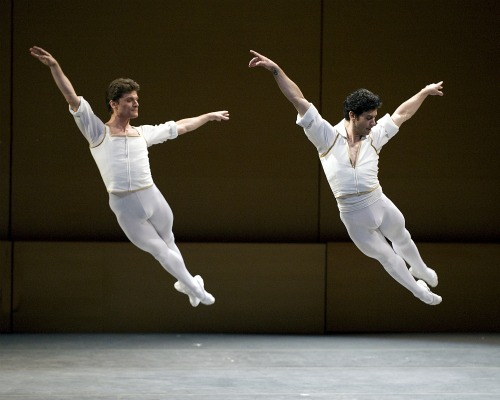
Gennadi Saveliev (left) and Herman Cornejo in Alexei Ratmansky's Seven Sonatas. Photo: Gene Schiavone
Saveliev seems to me to have become a somewhat warmer, more relaxed presence onstage. In the past I’ve found him stiff, but in Seven Sonatas and In the Upper Room, he’s responsive to those with whom he dances and to the nuances of the movement. Suddenly he came into clearer focus.
The most understated work of the season was The Garden of Villandry, created by Clarke, Robby Barnett, and Felix Blaska in 1979 for the short-lived company Crowsnest and transferred to ABT’s Martine van Hamel, Ross Stretton, and Michael Owen in 1988. In the current production of this precariously balanced pas de trois to Schubert’s Trio No. 1 in B flat, a woman (Kent) dances with two men who love her (Bragado-Young and Roman Zhurbin) and whom she loves. To say they “dance” may be misleading. Wearing fin-de-siècle attire, they simply walk together. The men stroll with their hands in their pockets or holding a lapel. A glance, a gesture, a turn tell of what lies beneath the surface. Perhaps because Clarke and Barnett had been in Pilobolus together, the tenuous, shifting forces among these three reticent, well-bred people are often expressed in a strange equilibrium that they maintain while pulling against one another, leaning out in a slant as they walk; if one person were to let go, you think, the whole intimate friendship would crumble.
While Biloch, violinist Ronald Oakland, and cellist Jonathan Spitz spool out the limpid Schubert sonorities, the choreography teases us with a tiny degree of suspense. Will the woman choose one of the men she embraces? Will one of them cede her to the other? But, really, we know the answer.
If Villandry makes a feature of its economy of means, Private Light, a premiere by Demis Volpi, shows a plethora of themes, moods, and styles. Volpi, still in his twenties, began choreographing while dancing in the Stuttgart Ballet and has clearly absorbed ideas from others as well as setting out to explore his own paths. Private Light is by turns arch and mysteriously, darkly, dramatic. A bit of this, a bit of that, set to an eclectic selection of music, ranging from bluegrass to Villa-Lobos, Albeniz, and others—all dazzlingly played on an array of guitars by Christian Kiss.
Volpi has certainly learned aspects of his craft. He knows how to make a theme reappear in a different guise, to reassure us with repetition. He’s good at theatrical timing. But, my, how he does jump around! In the opening, five couples are onstage, embracing. The women have their backs to us, and they and their partners turn their heads this way and that to convey sweet mouth-to-mouth kisses. This excites the women. Lifted slightly off the ground, they wriggle their feet (in pointe shoes) in the air. Next, there’s a sequence reminiscent of the “Mistake Waltz” in Jerome Robbins’s The Concert. One man lugs the women to form a weird tableau, but keeps rapidly rearranging them, as if he were doing it on his lunch break and had to hurry.
Simone Messmer (wonderful) performs a solo that has her alternately, confrontationally bold and weak as a kitten. Stearns arrives to catch her and manipulate her through a duet (she keeps collapsing) that ends in a kiss. When Joseph Gorak executes a slow, carefully designed solo at the front of the stage, the mood and the atmosphere turn unaccountably ominous. The other dancers stand clumped together at the back in semi-darkness, watching him. They advance, he retreats, and vice versa. In the end, they absorb him into the group, and he’s fine with that.
The title Private Light might well refer to Bonnie Beecher’s dramatically effective lighting, but I think it’s meant to justify the diversity of the scenes. These include one in which Gray Davis, Roddy Doble, and Tamm do a lot of things with compliant Sarah Lane, and she kisses them all. Volpi appears to have gotten enthusiastic about several images and pieces of music, put them into a suite, and figured out a title and certain carry-over motifs that would bind everything together. Foolish and clever, transparent and murky at the same time, Private Light, nevertheless seemed to charm the crowd at the opening night gala, although you could almost hear critics’ teeth grinding beneath the intermission babble.
You can’t ignore the fact that works by Tharp, Cunningham. and Taylor shine (or shone) most brightly when performed by their own companies, but I love the verve and intelligence with which ABT’s dancers enter into the style and spirit of undertakings outside their classical home on the range.

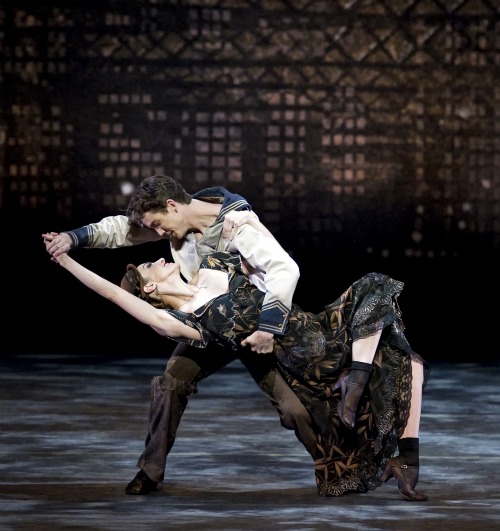
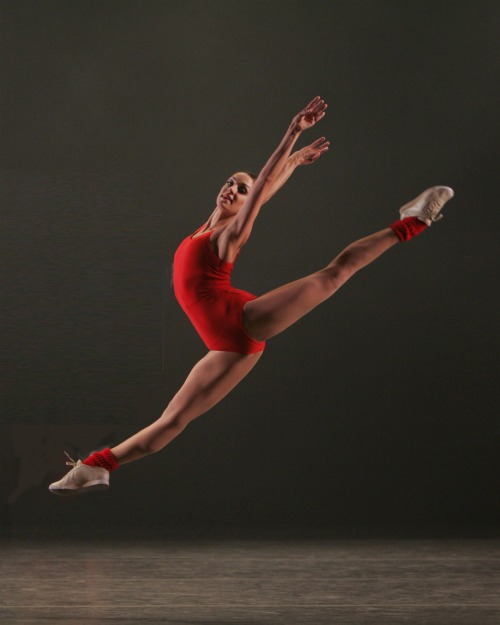
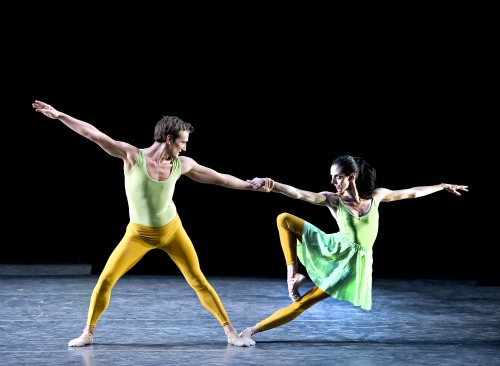
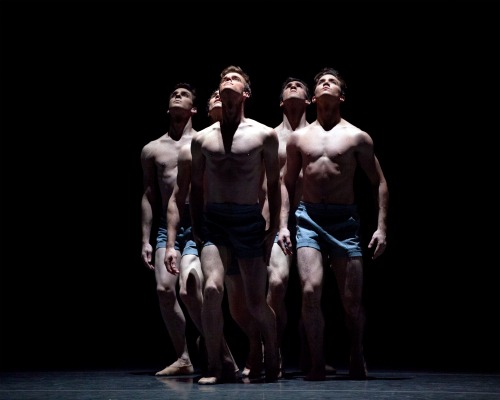
Deborah — May I offer a small correction? You say that “Four of the offerings—works ABT has performed before—were by choreographers associated with modern dance,. Clearly you were thinking of the four choreographers (since for ?Villandry” you mention only Martha Clarke), but together they provided seven of the nine ballets this season — an easy confusion to make.
George
I’m grateful to George Dorris for having caught my error and for pointing it out. I have amended the post. He’s right in thinking that I was adding up choreographers rather than works, so I can’t even justify the error by confessing to a serious weakness in basic math. Deborah J.